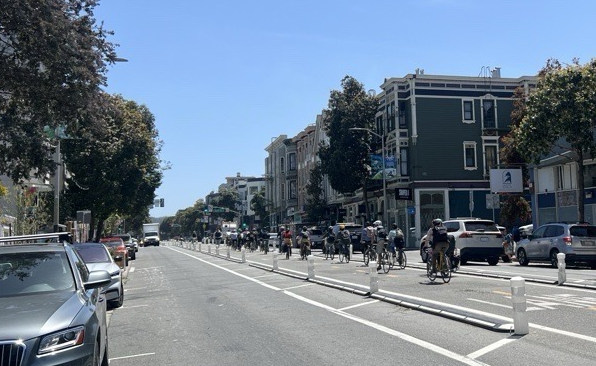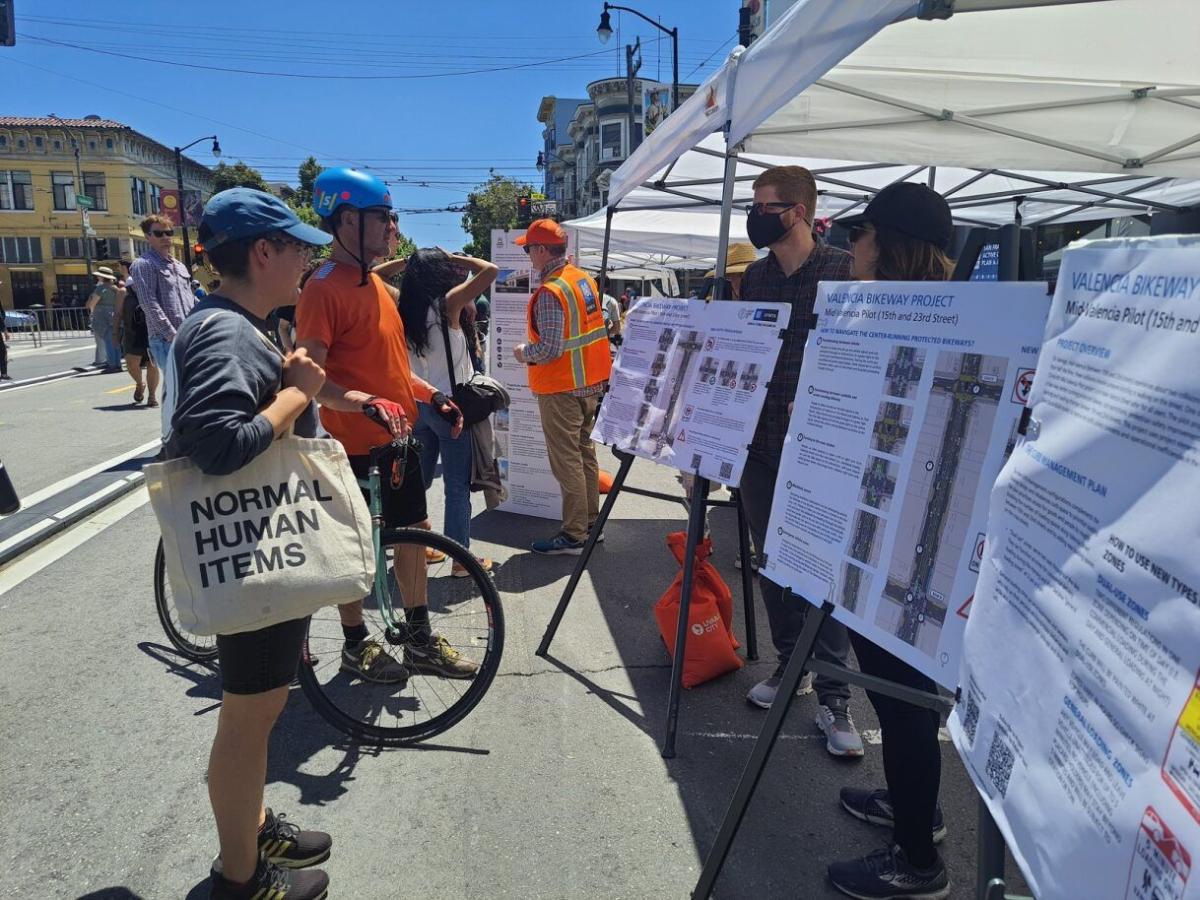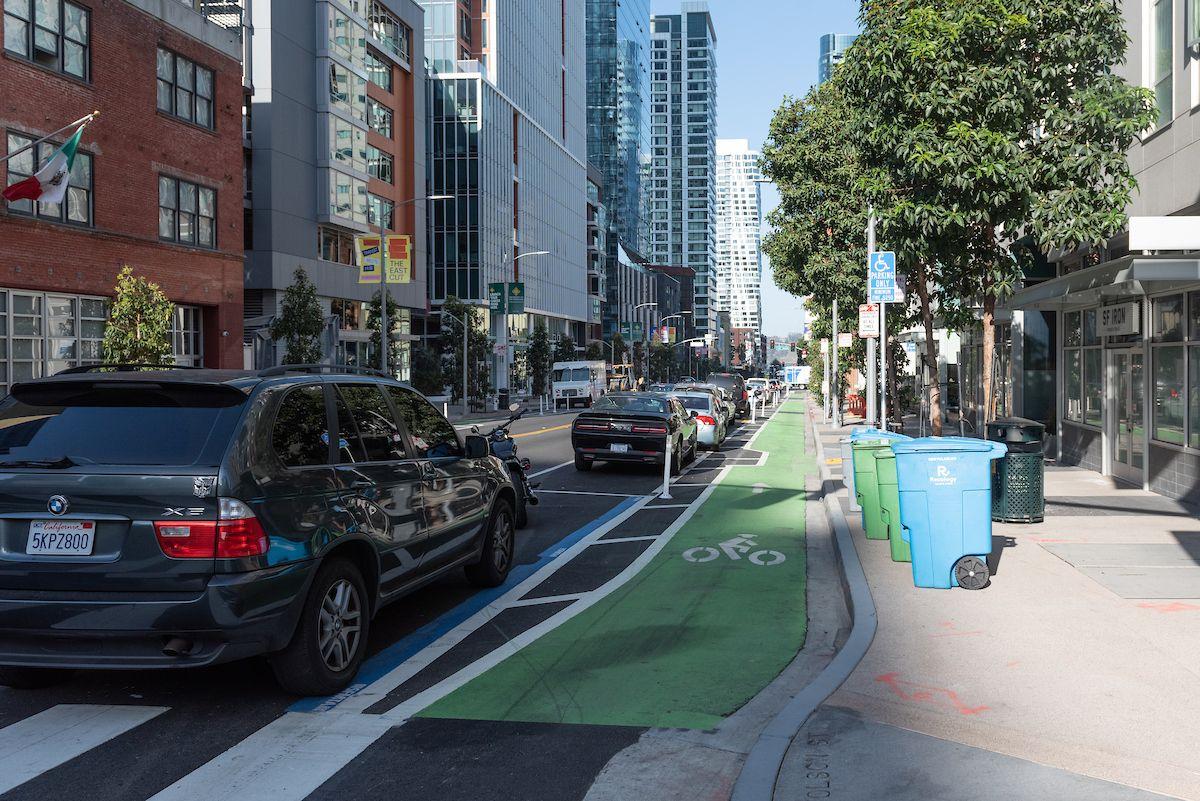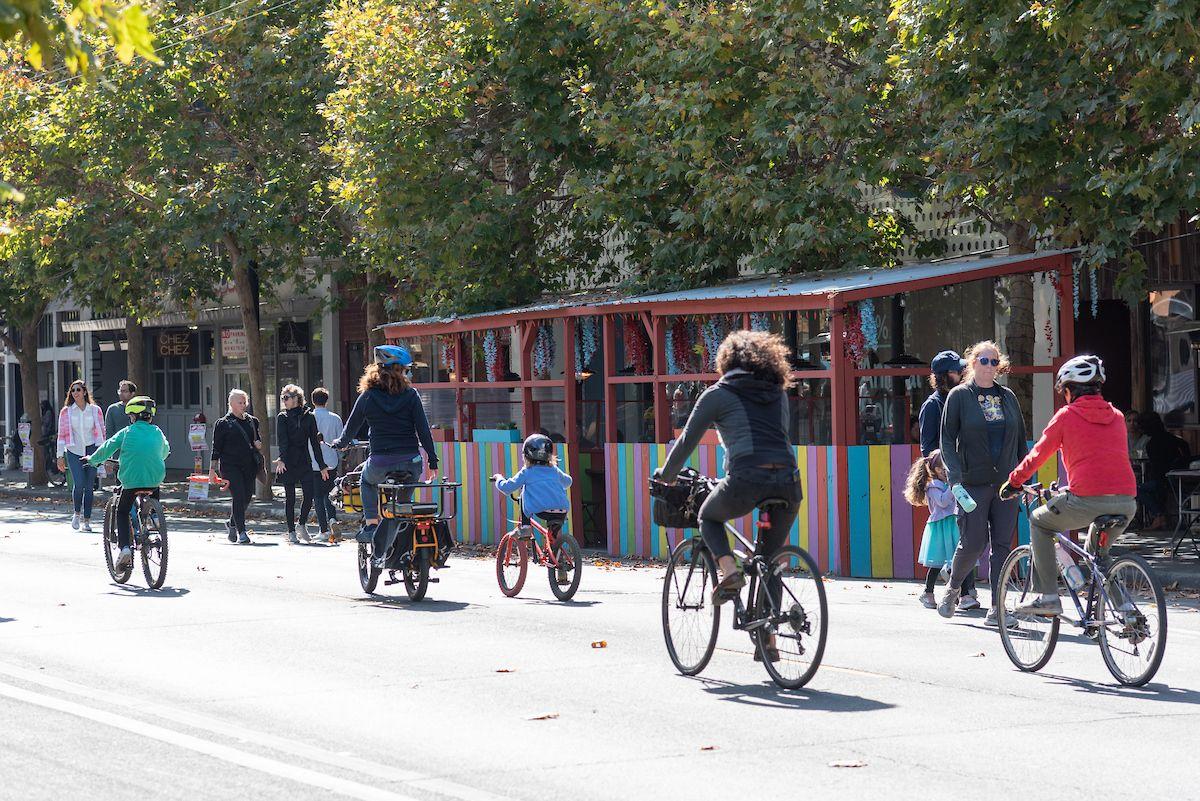
People riding on the current center-running bikeway on Valencia.
The bikeway on Valencia Street is changing, and we invite you to share ideas before we take next steps.
On June 18, our Board of Directors will vote on a side-running bikeway concept for Valencia. If they approve this option, we will develop a final design for a side-running bikeway. You can share feedback either before the June 18 board meeting or during public comment. Visit the SFMTA Board of Directors webpage for more information.
This vote follows a series of changes to improve the current center-running bikeway. We'll share more about our findings on the pilot and the potential path forward.
Center-running bikeway pilot successes and challenges
Responding to safety concerns
We launched the center-running pilot to solve a unique and growing safety problem. During the pandemic, demand for parklets and delivery services (food and goods) contributed to the most double-parking in the bike lanes since they were first painted in 1999. Blocking the bike lane forces people biking to merge into vehicle traffic, which increases the risk for collision and injury.
Merchants and community members asked us to prioritize immediate safety improvements – with as few changes to parking, loading and parklets as possible.
The center-running bikeway pilot addresses these concerns in three ways:
- Provide more separation between vehicles and people who walk and ride bikes
- Keep as much curbside parking and loading as possible
- Maintain curbside parklets
Evaluation data shows the pilot improved safety and comfort for people biking. It reduced vehicle conflict and maintained curb access. Plus, it left parklets undisturbed. However, we also heard that the center bikeway is not working for everyone.

We've been working to gather feedback from community members, business owners and more to hear about their needs for the corridor.
Using feedback to improve the bikeway
Within the first three months of implementation, our staff responded to feedback from a range of community members. We adjusted signage, color curbs and signal timing.
At the six-month mark, results showed improvement in bicyclist safety from the previous bikeway on Valencia. That design had a painted bikeway placed between moving and parked vehicles.
For example:
- Before the center-running pilot, 67% of loading and unloading took place with a vehicle double-parked, and 40% of those incidents involved vehicles blocking the bike lane.
- After the center-running pilot, 14% of loading and unloading took place with a vehicle double-parked, and only .1% of those incidents involved vehicles blocking the bike lane.
At the same time, some community members said they were confused by the pilot’s changes to traffic patterns, like turn restrictions. While the center-running is easy for folks to bike straight down Valencia, it’s taken time for bicyclists to understand how to turn onto side streets. And it’s more complicated to reach mid-block destinations. All users have had to learn and adjust, and new visitors are still surprised by a bike lane in the middle of the road. Some merchants want more changes for parking and loading.
We’ve learned a lot from the center-running bike lane, both its benefits and challenges. For Valencia, it’s been a step forward that shows the corridor can’t go back to how it was.

On June 18, our Board of Directors will consider a side-running bikeway design. Here's an example on Folsom Street.
Considering a side-running design: what could be next and why
We recognize that the center-running bikeway is a new idea in San Francisco. The trade-offs are different from more familiar side-running protected bikeways in the city. Examples include Folsom Street, Howard Street, San Jose Avenue, The Embarcadero and Battery Street.
We continue to work directly with community members to find the right option for Valencia. Our teams have been doing extensive outreach to plan and design a side-running bikeway option.
We have spoken to hundreds of merchants, parklet owners and service providers along Valencia in recent months. During a series of block meetings with merchants, we discussed draft designs, collected needs and compared tradeoffs. This helped inform the conceptual side-running design.
This summer, we’ll continue to meet with merchants and connect with a wider range of stakeholders. We’ll consider all input as we move on to a detailed design phase.
Understanding trade-offs is a crucial step in this process. As our Board of Directors discussed in a February SFMTA Board Meeting, these could include more changes to traffic, parklets, parking and loading.
Here’s a look at potential impacts:
- Parklets: A side-running bikeway will have to either navigate around curbside parklets or run between the sidewalk and floating parklets.
- Parking: A side-running bikeway may remove approximately 41 percent of spaces. This would improve visibility at cross streets, alleys and driveways. It would also ensure access to fire hydrants.
- Traffic: A side-running bikeway is likely to be more intuitive for drivers. It will also likely include turn restrictions and protected intersection treatments since vehicle right turns will cross the bikeway.
- Bikeway width: The new side-running bikeway would have to narrow in some places.
Staff will present a conceptual design at the next SFMTA Board Meeting on June 18. If our board of directors endorses the plan, our team will engage the wider community in additional outreach. Next, we will produce a detailed design for the side-running option, including exploring place-making opportunities. This will be presented at a board meeting in late 2024 for their approval.

Valencia has had bikeways for 25 years. We’re partnering closely with the community to find the right option for the corridor.
Creating long-term plans for Valencia
We’re also creating a long-term strategy for Valencia. In addition to redesigning the corridor, we’re working on three studies. They focus on traffic circulation, placemaking and curb management.
All of these efforts are the latest in the evolution of Valencia Street, a 149-year-old corridor that’s had bikeways for 25 years. It’s one of our city’s most vibrant business districts, and we’re excited to work with the community to shape its future.
For more information on the pilot and potential next steps, visit the Valencia Bikeway Improvements project webpage (SFMTA.com/ValenciaBikeway).